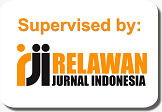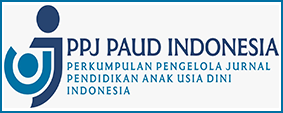MANFAAT PEMBELAJARAN FINGER PAINTING BAGI ANAK USIA DINI
Abstract
Education is closely related to the process of organizing to fully achieve educational goals. Using appropriate learning methods in the learning process is one of the keys to the success of the learning process. Good learning methods need to be adapted to the age of students, because there are many learning techniques in learning methods that educators can apply to achieve what they want to achieve. Learning to draw with practice with finger painting technique is a form of adapting teaching and learning techniques used by TK Kusawa Hanagiri by taking into account the age level of students. Based on this, the writer then carried out qualitative descriptive activities and finger painting which was supported by data analysis using the triangulation stage using data collection techniques in the form of observations, interviews, and library searches. The following are the results of the analysis of the mean of finger painting learning in Kusawakagiri Kindergarten. Based on these results, there is some debate. 1) Finger painting develops students' imagination. That is, the child's imagination, which is mainly influenced by the environment, is acquired in the process of observing the child and in himself. Through this process, the head that is built will be able to foster children's creative thinking and develop their intelligence, enabling them to think critically. 2) Finger painting fosters student creativity. In short, learning finger painting allows children to create new conditions based on existing data, information and elements (creativity). 3) Painting with fingers as a source of inspiration, painting with fingers as a source of implied inspiration is a detailed practice process for students.
References
Fitriani, Dewi., dkk. 2019. Aplikasi Kegiatan Main Finger Painting Dalam Peningkatan Kreativitas Motorik Halus Anak Usia Dini. Jurnal Pendidikan Anak Bunayya.Vol. VI, No.2: 204-217.
Irham, Muhamad dan Novan Ardy Wiyani. 2013. Psikologi Pendidikan. Jogjakarta: Ar-Ruzz Media.
Moleong, Lexy. (2005). Metodologi Penelitian Kualitatif. Bandung: PT Remaja Rosadakarya.
Muskibin, Imam. 2009. Dibesarkan Kantong Ajaib Doraemon; Waspadalah Para Orang tua, Bila Si Kecil Diasuh dan Dididik Doraemon. Yogyakarta:Diva Press.
Sugiyono. (2014). Metodologi Penelitian Pendidikan Pendekatan Kuantitatif, Kualitatif, dan R&D. Bandung: Alfabeta.
Sugihartono, dkk. 2007. Psikologi Pendidikan. Yogyakarta: UNY Press.
Suryabrata, Sumadi. 2013. Psikologi Pendidikan. Jakarta: PT. Raja Grafindo Persada.
Surya, Mohamad. 2015. Strategi Kognitif dalam Proses Pembelajaran.. Bandung: Alfabeta.
Utami Munandar. 1999. Pengembangan Kreativitas Anak Berbakat. Jakarta: Rineka Cipta.
https://kbbi.web.id/imajinasi pengertian imajinasi (diakses pada tanggal 18 Januari 2022).
http://rahmisyahputri99.blogspot.co.id/2014/12/mengembangkan kreativitasanakusia.html (diakses pada tanggal 18 Januari 2022).

This work is licensed under a Creative Commons Attribution-ShareAlike 4.0 International License.
Authors who publish with this journal agree to the following terms:
- Authors retain copyright and grant the journal right of first publication with the work simultaneously licensed under a Creative Commons Attribution-ShareAlike 4.0 International License that allows others to share the work with an acknowledgement of the works authorship and initial publication in this journal.
- Authors are able to enter into separate, additional contractual arrangements for the non-exclusive distribution of the journals published version of the work (e.g., post it to an institutional repository or publish it in a book), with an acknowledgement of its initial publication in this journal.
- Authors are permitted and encouraged to post their work online (e.g., in institutional repositories or on their website) prior to and during the submission process, as it can lead to productive exchanges, as well as earlier and greater citation of published work (See The Effect of Open Access).











.png)














